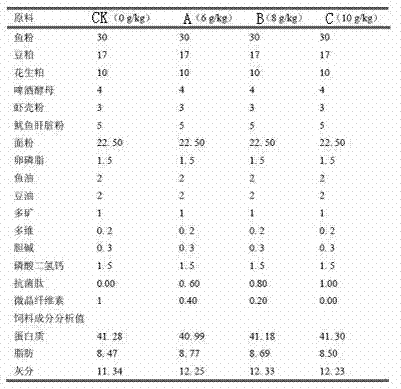Production method of bacillus amyloliquefaciens antimicrobial lipopeptide and application thereof in prawn feed
A technology for dissolving starch spores and a production method, applied in the field of aquaculture, can solve the problems of narrow antibacterial spectrum, restricting the large-scale use of feed, etc., and achieve the effects of promoting growth, regulating immunity, improving feed utilization, and reducing mortality.
- Summary
- Abstract
- Description
- Claims
- Application Information
AI Technical Summary
Problems solved by technology
Method used
Image
Examples
Embodiment 1
[0024] Bacillus amyloliquefaciens ( Bacillus amyloliquefaciens ) fmb-50 is Bacillus amyloliquefaciens ES-2-4 via N + The high-yielding mutant strains bred by ion mutagenesis, the high-yield mutant strains bred by nitrosoguanidine mutagenesis, and other high-yielding mutant strains obtained by protoplast fusion were named fmb-50. B. amyloliquefaciens fmb-50 can obtain the highest antibacterial lipopeptide production with corn flour as the carbon source, and its production is 3.4 times that of the parent strain ES-2-4. [Yao Shulin, Lu Zhaoxin et al., Taguchi method optimization B. amyloliquefaciens fmb-50 surfactin-producing industrial fermentation medium, Journal of Beijing University of Chemical Technology, 2012,39(4):77-83]. Original strain of fmb-50 B. amyloliquefaciens ES-2-4, B. subtilis 168 and B. subtilis fmbJ (the strains are all known and public, see Huang Xianqing, etc., the effect of Bacillus subtilis fmbJ lipopeptide inhibition point Penicillium and ...
Embodiment 2
[0031] The activated pathogenic bacteria Vibrio parahaemolyticus, Vibrio harveyi, Vibrio alginolyticus, Streptococcus agalactiae (the strains are all known and public, see Chen Jixiang et al., Pathogenic Vibrio harveyi hemolytic Gene cloning and detection, 2005, Chinese Fisheries Science; Zhai Xiumei etc. Effects of Vibrio parahaemolyticus on physiological and biochemical indicators of Penaeus vannamei, 2007, Journal of Shanghai Fisheries University; Yan Qingpi et al., Effects of different environmental conditions on the adhesion of Vibrio alginolyticus to intestinal mucus of large yellow croaker, 2006, Acta Aquatica Sinica; Wu Yingrui et al., Research on the inhibitory activity of 153 kinds of Chinese herbal medicines against Streptococcus agalactiae and Streptococcus iniae in tilapia, Journal of Northwest A&F University, 2013) respectively received in TSB (tryptone soybean liquid medium), cultured at 36±1℃ for 4 ~6 h, adjust bacterial OD with TSB medium 600 value, to a ...
Embodiment 3
[0039] Litopenaeus vannamei with normal appearance, healthy body and average tail weight of 1.02 ± 0.10 g were selected as experimental shrimps. Fish meal, soybean meal, peanut meal and brewer's yeast were used as protein sources, fish oil and soybean oil (1:1) as fat source, flour as carbon source, and appropriate minerals and vitamins were added as compound feed for Litopenaeus vannamei (Table 2 ). According to adding 6g (A group), 8g (B group), 10g (C group) described antimicrobial substance feed additive (preparation in the first method in embodiment 1, potency 40000 IU / g) in every kilogram of compound feed, CK group without antibacterial substances (Supplementary Table 2). Three repetitions were set up for each treatment, and 30 Litopenaeus vannamei were stocked in each glass steel bucket, and the water capacity of the glass steel bucket was 0.3 m 3 . The water temperature was (27. 5 ± 1. 5) ℃, the seawater specific gravity was 1. 012 ± 0. 002, and the breeding experi...
PUM
 Login to View More
Login to View More Abstract
Description
Claims
Application Information
 Login to View More
Login to View More - R&D
- Intellectual Property
- Life Sciences
- Materials
- Tech Scout
- Unparalleled Data Quality
- Higher Quality Content
- 60% Fewer Hallucinations
Browse by: Latest US Patents, China's latest patents, Technical Efficacy Thesaurus, Application Domain, Technology Topic, Popular Technical Reports.
© 2025 PatSnap. All rights reserved.Legal|Privacy policy|Modern Slavery Act Transparency Statement|Sitemap|About US| Contact US: help@patsnap.com



